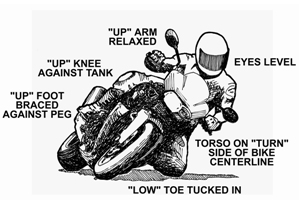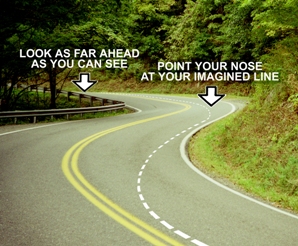You don't have to hang way off the bike in every curve to achieve
better cornering control. Just sliding from one side of the saddle
to the other will have an effect. But if you do want to hang off
more aggressively, here are some pointers:
1. Hang off early
Shift your weight before you lean the bike into the curve. Get
your entire upper torso to the "turn" side of the bike centerline
two or three seconds before your turn-in point. You may have to hold
some pressure on the "up" grip to keep the bike from turning until
you're ready. At the turn-in point, simply relax your steering input
to allow the bike to lean over.
2. Get tucked in
Wedge your "up" knee against the tank to prevent sliding off too
far. Brace your "up" leg against the footpeg. Tuck your "down" toe
in to prevent snagging it on the ground. You don't want to get your
foot caught between the peg and the pavement.
3. Eyes level.
Tilt your head to keep your eyes level with the horizon. Level
eyes provide a more stable view of the road, and that helps you
understand the shape of the curve and predict where the bike is
headed.
4. Countersteer.
With the bike leaned over, press the grips toward the direction
you want to go. In a left turn, pressing both grips toward the left
will lean the bike over farther. Or, as Total Control author Lee
Parks suggests, steer with one hand. In a right-hander, steer with
your right hand. In a left-hander, steer with your left hand.
Below: If you decide to add "hanging off" to your set of
riding skills, learn to do it right.

Eyes Up
Whatever the bike you're riding, or however aggressively you are
riding it, it's very important to get your eyes up. At a road speed
of only 55 mph, you're covering almost 80 feet per second. Even if
you notice a hazard and try to take some evasive action, it takes
time to make it happen. A reaction time of one second is very quick.
Even if you are able to react within one second, you will have
covered 80 feet before anything happens. In other words, at 55 mph,
that next 80 feet ahead of the bike is history. The message is:
there's no point in looking down at the pavement 50 or 60 feet in
front of the bike.
Looking farther ahead gives you more time to react to what you
see. So, get your eyes up, and scrutinize what's happening as far
down the road as you can see details.
Point Your Nose
We tend to point the bike where we are looking. And we also tend
to point the bike in the direction our face is headed. So, it helps
to actually turn your head and point your nose where you want the
bike to go. As you lean the bike into a turn, keep your eyes level,
and look around the corner as far as you can see. But resist the
urge to stare at the painted lines. Instead, imagine your line
through the turn, and keep your nose pointed where you want the bike
to go.

At right: There's no point in looking down in front of the
bike, because whatever happens within the next second or two is
already history. Get your eyes up, scrutinize the road as far ahead
as you can see, and point your nose at the line you want the bike to
follow.
Crash Padding
If you want to avoid running into something, you have to be able
to either swerve around it, or stop short of it. Either way, you
need to be able to control the bike within the road you can see. The
shorter your sight distance, the more you are depending upon luck
rather than skill.
One of the big challenges of very twisty roads with tight bends
is that the view ahead is frequently limited. Even if you are very
skilled and your reaction times are very quick, it's easy to find
yourself going way too fast to be able to respond to a hazard that appears
suddenly, halfway around the turn. You may be in good control of the
bike, but not in control of the situation. The chances are that
sooner or later some situation will exceed your skill and knowledge
levels.
For that reason, clever riders wear impact and abrasion resistant
riding gear. The message is: when you get your turn to crash, you'll
be sliding down the pavement in whatever you chose to put on before
the ride. If your riding gear is comfortable and functional, you're
more likely to wear it "ATGATT". (All The Gear, All The Time).
David Hough
is a long-time motorcyclist and journalist. His work has appeared in numerous motorcycle publications, but he is best known for the monthly skills series "
Proficient Motorcycling
" in Motorcycle Consumer News, which has been honored by special awards from the Motorcycle Safety Foundation. Selected columns were edited into
two books
Proficient Motorcycling
and
More Proficient Motorcycling
, both published by Bowtie Press. He is also the author of
Driving A Sidecar Outfit and a pocket riding skills handbook,Street Strategies
.
